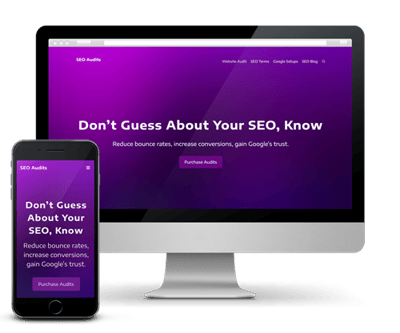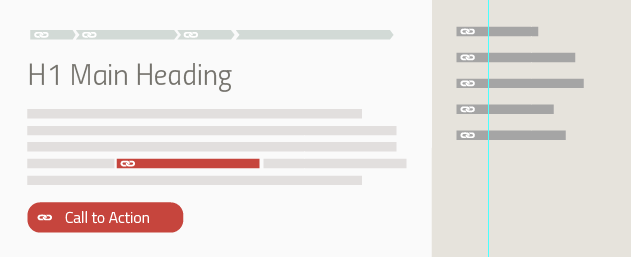
In the same way that a good written document (like a report, or newspaper article) should be arranged in a certain way to make it more accessible to readers, it’s a good idea to structure your webpages so they are easy for Google and the other search engines to crawl and understand.
The best way to envision search-friendly content structure, and a big-picture sense, is to imagine the inverted pyramid preferred by journalists around the world. At the top, you have the most important ideas and keywords, with additional details being added as the content goes along.
This means that you’ll almost always want big ideas, and key phrases associated with them, to be found at or near the top of your page. So, your prospects' most common search phrases should be incorporated into page titles, H1 (main heading) tags, and subheadings (and URLs if possible). Then you can structure your content in a way that makes it easy to read and understand as you add more thoughts to the piece.
As you develop and refine your content (static pages and blog posts included), you should pay particular attention to:
Google pays a lot of attention to your page titles, just as you would the title of the document. Make sure that your titles are descriptive, and that they include any important search phrasing that you are topically focusing on.
 2. Including a meta-description that invites readers to click through to your content.
2. Including a meta-description that invites readers to click through to your content.Although search engines won’t pay attention to your meta-descriptions, they will display them within search results (note: Google may opt to insert other text from your page). That gives you an opportunity to prompt readers to click through.
Your H1 headline is like the title of a magazine. You only get one to use. It should be search-friendly, and irresistible to your core prospects.
Don’t forget the inverted pyramid. Google pays more attention to content at the top of the page or article, so your most important idea should be found here.
Images are indexed by search engines, but more importantly, as visuals, they can work very well to attract readers. Choose a photo or image that’s relevant to your message, add branding if necessary, and be sure to use search-friendly alt text. (Tip: view your image as a thumbnail... it should be recognizable even at a tiny size. Solid, simple colours work well.)
These help you highlight or recap main points, break up the flow of text on a page, and signal to Google and the other search engines that you have something important to point out. Use them lightly to highlight special points, not as the default paragraph formatting.
Always give readers something new (or next) to do when they reach the end of your piece. The links you add to your pages matter (see below), and it’s important for you to lead searchers in the right direction.
Strong file names include keywords being used in a natural, straightforward way. Use dashes to separate words in a phrase as opposed to all as one word in your page titles, and stay away from generic numbers or special characters that obscure the topic.
Include hyperlinks with varying anchor text (the text you select and link) – very important for search optimization of your content. That’s because Google can follow the links and infer meaning from the phrases you use to guide a reader from one page to another.
However, while you should certainly link between different pieces of content, you shouldn’t do it too often. That’s because Google and the other search engines will essentially divide the power of each link (or, Juice) by the number of links on a page.
For example, if you have two links within your content, each will get 50% of the “juice” available to pass onto the linked page(s). If you have 10 links, on the other hand, each link only gets 10% of the available authority (note that Google generally overlooks navigation elements in these determinations - just remember you will want to favour a positive user experience over dumping a long list of links on sidebars or footers). It’s also good to remember that links placed higher on a page get slightly more weight, so you should try including the most important link in the first couple of paragraphs if possible.
Of course, the best links aren’t put into place solely for search engine optimization purposes, but to encourage a visitor to read and learn more on their way to contacting you. For that reason, they should be placed within the body of a paragraph at a point that feels natural, so someone who is reading your content can act on an opportunity to learn even more.
In addition to making your site more relevant and useful for humans, this also helps your search positioning. When Google sees that users are taking time to go through multiple pages on your site, following one link to another, it sends a positive signal that you are a relevant and authoritative source of information.

One special reminder should be given about links in the form of graphical calls to action, which should accompany all of your blog content (at the bottom of the article) and on pages where appropriate to be helpful. These are important not just for the purposes of search structure, but to generate conversions on your website.
Believe it or not, there's a bit of psychology to the placement of links vs. graphical CTAs. Consider for a moment that a hyperlink and a graphical CTA reside in close proximity to one another on a page. A reader who is interested in clicking the CTA (being large and colourful with an obvious prompt like the example at the bottom of this article) would understand that they are not simply navigating to another page to read, but going to an actionable item. Whereas, the reader clicking the hyperlink is likely still in reading or discovery move, not yet at a point of taking action. In a nutshell, clicking one or the other is indicative of intent (and by extension, of interest or commitment).
 David Amerland
David AmerlandOne thing you may want to address is that Google has stopped updating external PageRank (PR) which they said was always intended to help searchers – they are probably still using internal PR but that is deprecated and there is the additional layer of links adding semantic value to a page (i.e. including links to high authority sites as additional reference or citing sources) and linking, internally, to pages that are complementary rather than simply suggestions to visit other content (a practice that seems to be all the more rare now).
As a matter of fact it is helpful to think of both internal and external linking practices as a means of building a link tree where everything is related and all the links, taken together, become something way greater than the article would have been on its own. Then the linking strategy begins to acquire specific SEO value in the eyes of Google and the page that is associated with it, also benefits.
[ Editor's note: David graciously proof read an advance version of this post. ]
Great reminder from David about contextual menus:
You know, those 4 or 5 links along the right sidebar on desktop where you link to highly focussed and related content that helps the visitor dig deeper or act on your content. If you have all the same sidebar links on many pages, you're missing an exciting opportunity to offer up additional related resources to a visitor who has already expressed an interest in your topic.
Topics: Search Engine Optimization, All Articles